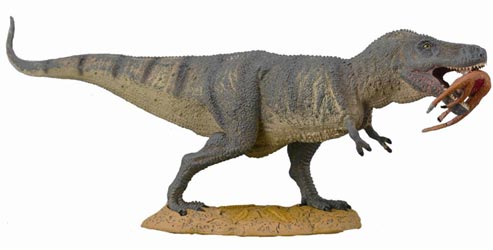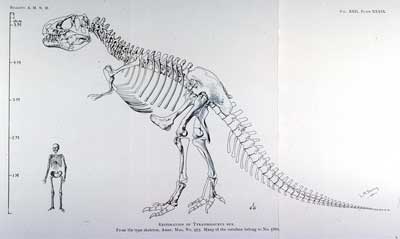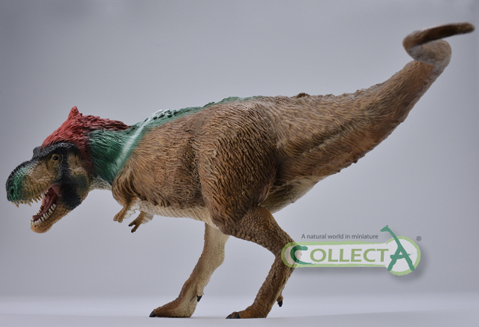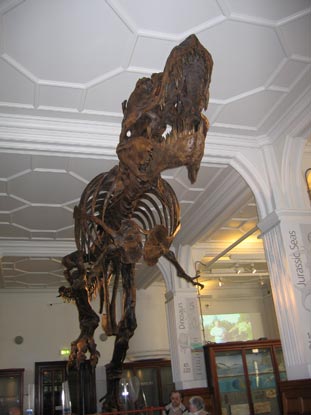New Paper Challenges the Idea of T. rex and Tiny, Useless Arms
Evolution is a very efficient process, either adapt and survive or fail to adapt and face extinction. That seems to be the general premise when it comes to “survival of the fittest”. However, one anatomical feature of the enormous theropod Tyrannosaurus rex seems to fly in the face of the theory of evolution, T. rex is famous for having tiny and puny arms. Are the tyrannosaurids sticking two figures up when it comes to natural selection? Not so, according to a new paper presented at the annual conference of the Geological Society of America (Seattle, Washington, USA).
Tyrannosaurus rex – Famous for its Disproportionately Small Arms

Vestigial Limbs?
Ever since the first partial skeletons of T. rex were discovered and as more fossils of this Late Cretaceous carnivore came to light, palaeontologists have puzzled over those “puny” arms. At the turn of the Century, during the period of the Barnum Brown fossil discoveries that led to the formal scientific description of the “tyrant lizard king”, no arm bones were found in association with the dinosaur, so it was assumed, that like Allosaurus more than 80 million years before, T. rex had three-fingered hands.
Our fascination with the forelimbs of Tyrannosaurus rex had begun. It was as recently as 1989, when arm bones of Tyrannosaurus rex were finally found and the didactyl hands seen in other, closely related tyrannosaurids such as Albertosaurus and Gorgosaurus were confirmed.
An Early Reconstruction of the Skeleton of Tyrannosaurus rex

Picture credit: Lindahall.org
Palaeontologist Steven Stanley (University of Hawaii at Manoa), challenges the perception that this dinosaur’s arms were almost useless. He suggests that earlier tyrannosaurids gradually evolved smaller forelimbs as their skulls and jaws became more massive, a hypothesis with lots of consensus amongst palaeontologists, but those tiny arms were actually very effective slashing weapons, ideal for close quarter combat.
Debunking the Idea of “Tiny, Puny” Arms
The arms of the Tyrannosauridae were certainly disproportionately small when compared to their massive bodies, however, Professor Stanley contends that at around 1 metre in length, the arms may have been relatively small, but they were exceptionally strong and with their two-fingered claws, with talons measuring up to ten centimetres long, they would have been capable of inflicting deep wounds in any dinosaur that got close. Whether the arms had a role in subduing prey or whether they were used in intraspecific combat, remains contentious.
Many palaeontologists believe that the reduced arms of tyrannosaurids were a consequence of natural selection favouring the evolution of giant skulls and super-strong jaws. The heads of tyrannosaurs, took over the role of grasping prey from the forelimbs and as the skulls and jaws became increasingly robust, the arms gradually got smaller and smaller as natural selection solved the issue of trying to counterbalance an increasingly heavy front end for the animal.
Six Traits Indicate That the Arms were Slashing Weapons
In the scientific paper, Professor Stanley identifies six derived traits that demonstrate that the arms of T. rex were not vestigial and that they could have served as slashing weapons.
- The short arms would have been ideal for close combat slashing, just as a small knife can be a very effective weapon in hand-to-hand combat.
- A large and broad coracoid bone suggests the arms were very powerful. The arms of T. rex were slightly longer than the legs of a six-foot-tall man and of similar girth.
- The arm bones themselves, particularly the humeri in a number of specimens are very thick and robust and the bones in the arm would have easily withstood the forces involved in slashing attacks.
- Tyrannosaurs are famous for having just two-fingered hands, the loss of the third finger allowed 50% more pressure to be applied to each claw.
- The humoral head articulating with the shoulder provided considerable mobility in the joint, all helpful when it comes to performing a slashing action.
- The sharp, keratinous-tipped claws measured between 8-10 centimetres long in the largest specimens, these would have inflicted metre-long, parallel slashes into the hide of any dinosaur that got too close.
Scientists have proposed several theories as to how T. rex used its short hands. They may have played a role in helping to grasp a mate during reproduction, or perhaps they helped this 7 Tonne dinosaur to stand upright after lying on the ground. Those much-maligned appendages could have had other uses, as Professor Stanley contends. The muddy waters surrounding the use to which T. rex put its hands have been made even murkier somewhat by more recent fossil discoveries. In 2009, Everything Dinosaur reported on the discovery of Raptorex kriegsteini, a 3-metre-long tyrannosaur that had the same body proportions of its more massive (and later), relative. Find the Raptorex article here: Raptorex Upsets the Tyrannosaur Apple Cart.
More recently, (2016), the discovery of the Late Cretaceous theropod Gualicho (G. shinyae) from Argentina, added more confusion to this puzzle. Although, Gualicho was not closely related to T. rex and its kin, it also had substantially reduced limbs and two-fingered hands. Perhaps, if Steven Stanley is onto something, then Gualicho too, could have utilised its reduced limbs as slashing weapons.
To read an article about Gualicho shinyae: Gualicho Sticks Two Fingers Up At T. rex.
Those Claws and Fingers were Evolved for Slashing

Professor Stanley states in the paper:
“Its short, strong forelimbs and large claws would have permitted T. rex, whether mounted on a victim’s back or grasping it with its jaws, to inflict four gashes a metre or more long and several centimetres deep within a few seconds and it could have repeated this multiple times in rapid succession. Infliction of damage by slashing was widespread among other Theropod taxa, so in light of its formidable weaponry, why should T. rex not have engaged in this activity?”
“Stanley Knives” on a T. rex
In summary, Steven Stanley suggests that the most famous of all dinosaurs was an even more formidable and dangerous dinosaur than previously thought. It possessed four, razor sharp claws (“Stanley knives” as a colleague referred to them as), these were perfectly adapted for helping this predator subdue prey.
Rather than being “puny” and “relatively useless”, these didactyl hands had evolved into effective close-quarter weapons, just as like the skull and jaws. Several palaeontologists have commented on the paper, suggesting that in close proximity, the massive jaws of this hypercarnivore would have been much more deadly, however, the slashing claws could have provided additional weapons for juveniles which had yet to mature and develop those immensely powerful skulls.
Tiny But Formidable Arms?

Picture credit: Everything Dinosaur
The scientific paper: “Evidence that the Arms of Tyrannosaurus rex were not functionless but Adapted for Vicious Slashing” by Steven Stanley and published as a paper at the annual meeting of the Geological Society of America.
Get your claws into the Everything Dinosaur website: Everything Dinosaur.






Just thinking out loud. Perhaps arms for caring for young offspring? Maybe used arms to get up in case t rex fell down? Maybe help climb a tree a short way to chase prey? Maybe to gouge/pick things out of small crevices where couldn’t fit head?
Thank you for your comment, it remains a puzzle, reduced forelimbs are found in the tyrannosaurs and in another group of large meat-eating dinosaurs not closely related to them the abelisaurs. The debate over their evolution is likely to continue and is not going to be resolved soon. Our thanks once again for your input.